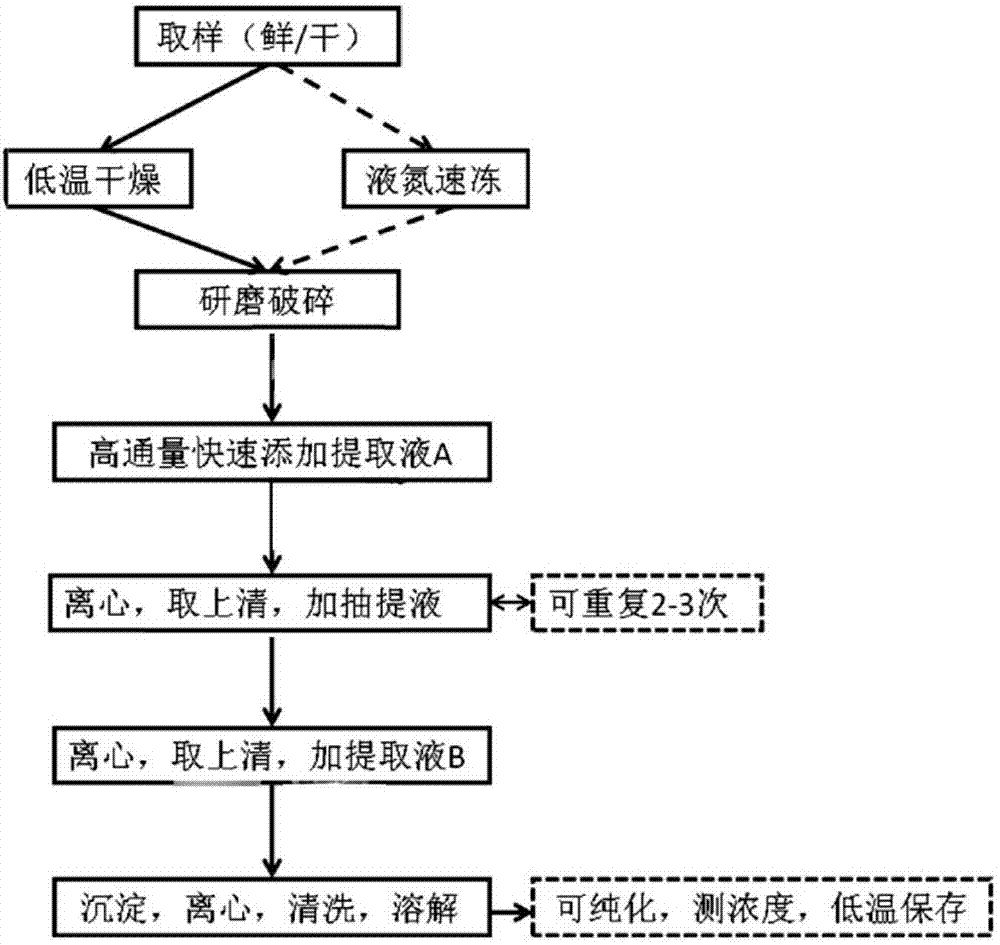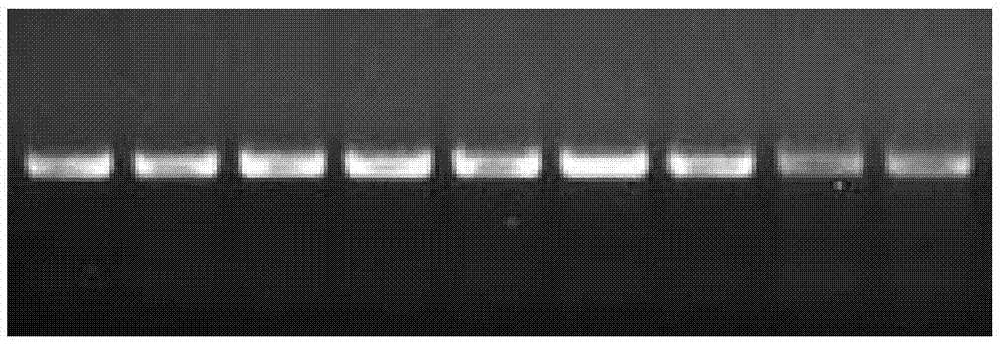Method for rapidly extracting DNA (Desoxvribose Nucleic Acid) of plant genome with high flux
A plant genome, high-throughput technology, applied in the basic field of molecular biology, can solve problems such as large differences in DNA results, difficult EP tube numbering, cross-contamination, etc., to achieve no protein and RNA contamination, and the extraction method is simple and fast. Extracted effects
- Summary
- Abstract
- Description
- Claims
- Application Information
AI Technical Summary
Problems solved by technology
Method used
Image
Examples
Embodiment 1
[0048] This example uses the Zephyr workstation combined with the improved CTAB method to extract genomic DNA from cucumber leaves. For the basic process, see figure 1 .
[0049] A: Test materials:
[0050] Take fresh cucumber leaves or vacuum freeze-dried leaves that have been stored for a long time and place them at the bottom of a 96-well deep-well plate. The volume of the leaves accounts for about one-fifth of the well volume. The amount should be kept as consistent as possible, otherwise the extraction efficiency of DNA will be affected.
[0051] B: Pre-freezing and quick-freezing and crushing of cucumber leaves
[0052] Before pre-freezing, remove the cover of the 96-well deep-well plate, put 2 steel balls (3mm in diameter, or balls of other materials) into each well; then place the deep-well plate (without the cover) The cover) is put into liquid nitrogen for quick freezing, or placed in a low-temperature drying device for low-temperature vacuum drying of the sample ...
Embodiment 2
[0070] This example is the Zephyr workstation combined with the improved NaOH method for high-throughput extraction of cucumber seed genomic DNA.
[0071] A: Test materials:
[0072] Put the cucumber seeds soaked and accelerated germination (the germ length is about 1cm) in a 96-well plate, or directly place the cucumber seeds (embryo facing down) in a 96-well plate, add an appropriate amount of water and then germinate at 27°C, and observe carefully during the period. It is optimal when the germ length exceeds 1cm (see figure 2 ).
[0073] Note: During the germination process, pay attention to replenishing water. Lack of water will cause the germ to lose water, affect the growth of the germ, and then affect the quality of seed DNA extraction.
[0074] B: Pre-freezing, quick-freezing and crushing of cucumber seeds / germs
[0075] If germination is directly carried out in a 96-well plate, before pre-freezing, absorb the water added during the germination process, and then pu...
Embodiment 3
[0090] This example is the Zephyr workstation combined with the improved SDS method to extract genomic DNA from cucumber leaves. For the basic process, see figure 1 .
[0091] A: Test materials:
[0092] Take fresh cucumber leaves or vacuum freeze-dried leaves that have been stored for a long time and place them at the bottom of a 96-well deep-well plate. The volume of the leaves accounts for about one-fifth of the well volume. The amount should be kept as consistent as possible, otherwise the extraction efficiency of DNA will be affected.
[0093] B: Pre-freezing and quick-freezing and crushing of cucumber leaves
[0094] Before pre-freezing, remove the cover of the 96-well deep-well plate, put 2 steel balls (3mm in diameter, or balls of other materials) into each well; then place the deep-well plate (without the cover) The cover) is put into liquid nitrogen for quick freezing, or placed in a low-temperature drying device for low-temperature vacuum drying of the sample for...
PUM
 Login to View More
Login to View More Abstract
Description
Claims
Application Information
 Login to View More
Login to View More - R&D
- Intellectual Property
- Life Sciences
- Materials
- Tech Scout
- Unparalleled Data Quality
- Higher Quality Content
- 60% Fewer Hallucinations
Browse by: Latest US Patents, China's latest patents, Technical Efficacy Thesaurus, Application Domain, Technology Topic, Popular Technical Reports.
© 2025 PatSnap. All rights reserved.Legal|Privacy policy|Modern Slavery Act Transparency Statement|Sitemap|About US| Contact US: help@patsnap.com



